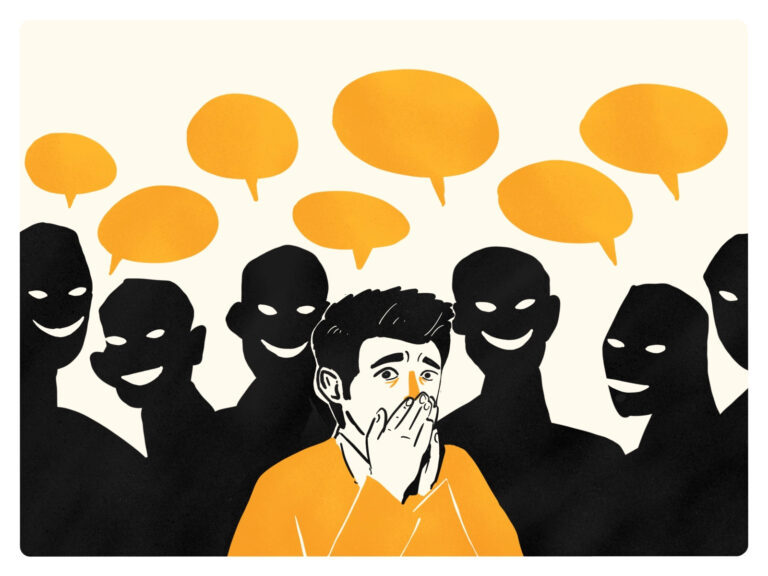Disclaimer: My content is NOT a substitute for professional advice, diagnosis, or treatment. When in doubt, ask a therapist
What is social anxiety disorder (SAD)?
Social anxiety disorder (SAD) is the persistent anxiety, fear, and avoidance of social judgment. APA says: “[SAD] is characterized by persistent fear and avoidance of social situations due to fears of evaluation by others.”
Here are a few of the many situations that can trigger social anxiety:
- Giving a speech
- Going on a date
- Talking to strangers at a party
- Voicing your opinion in a meeting
But how is SAD different from the usual social anxiety that we all face? And how treatable is it?
Before I answer all that, let’s first look at the stats:
How common is it?
According to research, anxiety disorders are the most common mental health disorders.
And what’s the most common anxiety disorder?
Ta-da!
“Social anxiety disorder is the most common anxiety disorder; it has an early age of onset—by age 11 years in about 50% and by age 20 years in about 80% of individuals”
— Murray B Stein and Dan J Stein
According to the National Institute of Mental Health (NIMH), one out of ten American adults will experience SAD at some point in their lives. Among young American adults (18-29 years old), it’s 9.1%.
The international prevalence of SAD is even more sobering. According to a study conducted in seven countries, more than 1 in 3 young people would meet the criteria for SAD.
And, while a lot of stats focus on prevalence, what’s often underappreciated is its persistence.
Researchers reported: “In clinical samples, SAD is the most chronic anxiety disorder, with a 37–56% remission rate”. Larry A. Cohen, the co-founder of the National Social Anxiety Center (NSAC), added:
“Without treatment, SAD tends to be lifelong. It’s the most persistent of all common mental health disorders.”
I can attest to this: I’ve experienced social anxiety since young, and while I’m much more able to manage the anxiety, it’s like an unwelcome old friend who keeps hanging around…
The difference between shyness and social anxiety disorder (SAD)
There’s a fair bit of overlap between shyness and SAD. Here’s how APA defines shyness:
“the tendency to feel awkward, worried, or tense during social encounters, especially with unfamiliar people.”
People with SAD exhibit these symptoms too. More importantly, both mental health conditions can lead to avoidance of social situations, which might negatively affect your quality of life.
Now, here’s where the similarities end…
- Degree of severity: Shyness is much less severe than social anxiety, as the chart above makes clear. Researchers also suggested that social anxiety is “extreme shyness”.
- Presence/absence of social fears: If you’re shy, it doesn’t mean that you’re scared of social interactions. Here’s what researchers of a study concluded: “About one-third of the highly shy without social phobia reported no social fears, highlighting heterogeneity of the shy.”
Here’s another thing that people including myself get confused about: is social anxiety bad? And why tack on “disorder” at the end of “social anxiety”?
The difference between social anxiety and social anxiety disorder (SAD)
Let’s get this clear right from the start:
An adequate amount of social anxiety is helpful and even necessary.
If we weren’t sensitive toward other people’s feelings and opinions, we’d be living in a society of sociopaths!
And throughout history, humans have been tribal creatures: our ability to form, maintain, and expand groups is crucial to our survival as a species.
What differentiates SAD from social anxiety is the following factors:
- High anxiety (to the point it causes a lot of distress)
- Persistent avoidance of social situations (both obvious and subtle i.e. safety behaviors)
- Significant impairment in functioning, for example, turning down work opportunities or social invitations.
Some therapists also argue that shame is the hallmark sign of SAD. Larry A. Cohen, LCSW, said:
“SAD is a shame disorder. It’s not just a phobia, it’s based on the core belief that we are fundamentally deficient, that we are not good enough. This is due to perfectionism, specifically we need to perfectly meet the perfect standards we think people have of us.”
Disclaimer: Even if you feel like you meet all the criteria, you will still need a professional diagnosis to confirm if you actually have SAD.
Now that you’ve learned more about social anxiety disorder is and isn’t, let’s differentiate between symptoms and signs, as this can often be confusing:
Symptoms & signs
Symptoms, as mentioned a few paragraphs ago, are what a therapist/clinical psychologist would diagnose for.
Signs of social anxiety are what you experience internally and externally. Here are a few examples:
- Your palms get sweaty or cold
- Your heart beats unusually fast
- Your mind goes blank (what to do when that happens)
- You worry about what they think (before, during, and even after the conversation)
Treatments
As challenging as SAD can be, it is very treatable! I speak based on experience and research.
Cognitive-Behavioral Therapy (CBT) is usually the recommended treatment — given the wide evidence base — but there are other effective options. Here’s a list of them:
- Exposure therapy: Exposure therapy is a CBT technique that helps you confront your fears. Learn more about exposure therapy here and here.
- Acceptance and Commitment Therapy (ACT): ACT focuses on changing your relationship with anxiety. Learn more about ACT and how it can help your anxiety here.
- Meditation & mindfulness: Either meditation or mindfulness can help you step outside your mind, so that you can focus on the conversation more. Check out these meditations and mindfulness techniques.
- Self-help: While professional help is ideal, it’s still very much helpful to educate yourself on social anxiety. I particularly trust the therapy workbooks by New Harbinger, or self-help books written by therapists. For the latter, check out my summaries here 🙂
Related articles

